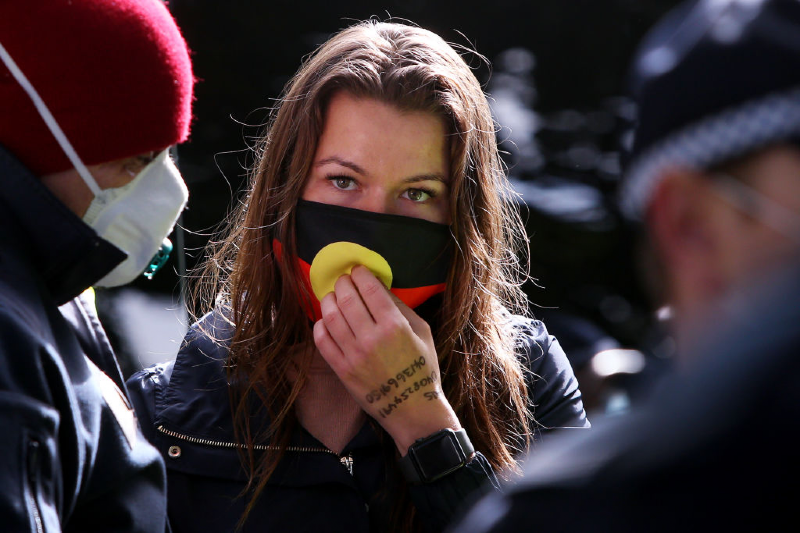- Cristy Clark
- 30 July 2020
The need to contain the spread of COVID-19 has led to a raft of emergency laws that have challenged us to deeply consider the appropriate balance between community and individual rights. When faced with these laws, it has been easy for people to resort to knee-jerk responses that either dismiss and minimise the concerns of individuals, or to characterise fairly benign measures as an unjustifiable breach of fundamental rights.

In order to explore whether there might be a more a principled approach to resolving these debates, let’s start by considering three quite different recent examples.
On Tuesday, NSW Police dispersed a Black Lives Matters (BLM) protest in Sydney and fined six of the organisers after they had been refused authorisation to gather in breach of the COVID-19 Health Directions.
Last week in Victoria, the Andrews government mandated face masks for all people (over 12 years of age) in the Melbourne and Mitchell Shire when they were out of their homes.
Finally, on Saturday 4 July, nine public housing towers in Melbourne were placed on ‘hard lockdown’ without notice, with hundreds of police rostered on to prevent residents from leaving for any reason, including to purchase food, medicine or other necessities of life.
In all three of these examples, the need to protect public health in the midst of a global pandemic was used to justify the actions taken. Nonetheless, all of these actions were controversial, and there has been extensive debate over their legitimacy. In this context, we need to consider the appropriate role of human rights in the context of a state of emergency, and how best to navigate the complex issues being raised.
'Nonetheless, even in an emergency context, if a measure does engage and limit human rights, there is a clear test that can be applied when considering whether it might be justifiable.'
First, it’s important to acknowledge that not only are few human rights absolute, but a state of emergency — which we are arguably facing — is broadly accepted to be a legitimate reason to limit many human rights. Nonetheless, even in an emergency context, if a measure does engage and limit human rights, there is a clear test that can be applied when considering whether it might be justifiable.
The first question to ask is whether the measure pursues a ‘legitimate objective’. (What is it trying to achieve, and is this a reasonable and justifiable end goal for a democratic government?)
The next question is whether it is ‘rationally connected’ to achieving this objective. (Is there any evidence to show that this measure is likely to succeed?)
Finally, is it proportionate? (Could the objective be achieved in a way that has less of an impact on human rights? Are there any safeguards that might better protect people’s rights?)
Okay, so now that we have a framework, let’s apply it to our three examples.
The refusal to authorise the BLM protest in Sydney, followed by the dispersal of the protest by NSW Police, clearly engages freedom of assembly and expression (i.e. the right to protest). These are widely acknowledged to be foundational rights, because they provide an essential means of holding the government to account and of protecting and realising other human rights. Case in point: this protest was about the right to life for Aboriginal and Torres Strait Islander peoples, as well as the rights to humane treatment in detention, equality before the law, and self-determination.
But, we must also ask whether the protection of public health (in the context of a global pandemic) is a legitimate objective for the government to pursue? Clearly it is. There is also evidence that COVID-19 infection rates are more likely to increase if people gather together in large crowds, especially if social distancing and other safety measures are not adhered to. On this basis, it would be hard to argue that banning the protest was not rationally connected to the protection of public health.
On the other hand, there is no evidence to suggest that anyone contracted COVID-19 at the previous BLM protests, and organisers had committed to promoting safety through distancing, masks and hand sanitiser. As such, banning this protest may have been a disproportionate means of protecting public health. To reach an informed conclusion, it would be helpful to know whether the NSW government had considered any less rights-restrictive approaches, such as working with the organisers to implement effective safety measures. The fact that other large gatherings have been authorised, including the football, emphasises this point, and raises further questions about the potentially discriminatory impact of this particular decision.
Let’s move on for now. What about mandatory face masks? To start with, we need to consider whether this measure even engages human rights. Despite claims to the contrary, there is no explicit human right to go out in public (during a pandemic) without a face covering. At a stretch, you might argue that mandatory face coverings may act as a limitation on freedom of movement, but, honestly, you probably wouldn’t find any jurisprudence to support this line of reasoning. So, we are left with the issue of discrimination.
If, for example, the Andrews government had passed an order that mandated that ‘all women must wear masks in public’, you might be able to argue that this was direct discrimination on the basis of a protected ground (gender, in this instance). But the current public health order is nearly universal in its application.
An alternative option would be to argue that this order represents indirect discrimination, because it may place a disproportionate burden on some protected groups — some people genuinely cannot wear a mask. However, the Victorian government appear to have taken this into consideration, as the order already provides for ‘a number of lawful excuses for not wearing a face covering including if you have a medical condition or other condition that impairs your ability to wear a face covering’.
In such a context, it is unnecessary to go into any further analysis, but it’s worth noting that we’ve already considered that protecting public health is a legitimate objective, and while there does appear to be some debate over the efficacy of masks, they are clearly rationally connected to slowing the spread of COVID-19. As for proportionality, since mandating masks doesn’t limit human rights it would be hard to argue that a less rights-restrictive approach should have been taken.
'This whole conversation may seem trivial or unnecessary in the context of such an unusual global pandemic. But the problem is, not only are we likely to see more pandemics in the future, we are also looking down the barrel of a much more significant, permanent emergency: climate change.'
The hard lockdown of the nine public housing towers in the suburbs of Flemington and North Melbourne is, perhaps, the most complicated of these three examples. It clearly engages a range of human rights, including the right to liberty, freedom of movement, health, and non-discrimination. It also clearly pursues the legitimate objective of protecting public health, and is rationally connected to that objective (it did, for example, allow for the rapid testing of all residents). So, once again, we are left with the question of proportionality.
It is hard to believe that there was not a more proportionate means of protecting public health than the actions that were taken on Saturday 4 July. Why were residents provided with no notice of the lockdown, particularly when this left them unable to stock up on essentials such as food, medicine and nappies? Why were authorities so slow to provide food parcels to residents? (It has been argued that they themselves were caught unprepared, but this only emphasises the adequacy of the of lead in time.)
It is also unclear why these communities were singled out for such extreme treatment, which relates to the question of whether the use of police — in such large numbers — to enforce the orders was the best approach. Here it should be acknowledged that local community legal centres believe that the impact of this approach was exacerbated by the fact that many residents had already experienced discriminatory treatment at the hands of local police.
This consideration of the broader policy context that preceded this order is perhaps the most significant and complex aspect of assessing its human rights implications. The fact that these public housing towers are such perfect incubators for COVID-19, due to overcrowding and the high numbers of people having to share common facilities such as laundries and lifts, highlights existing human rights issues that should have already been acted upon both in the early stages of the pandemic and before. If we are going to learn any lessons from this experience, one of these should be that the protection of human rights requires a responsive state that acts early to build community resilience.
You may well be asking, can’t we set human rights aside right now and focus on fighting COVID-19? This whole conversation may seem trivial or unnecessary in the context of such an unusual global pandemic. But the problem is, not only are we likely to see more pandemics in the future, we are also looking down the barrel of a much more significant, permanent emergency: climate change.
If we don’t want to see the steady erosion of human rights once our governments start to actively respond to the climate emergency, we may need to treat this current pandemic as a test run for how to best navigate the apparent tension between emergency laws and human rights. A starting point might be to encourage a stronger grasp of what human rights actually are (and what they are not), and to work to build a stronger human rights culture within our governments, social institutions and wider Australian society.
 Dr
Cristy Clark is a human rights specialist. Her work focuses on the
intersection of human rights, neoliberalism, activism and the
environment, and particularly on the human right to water.
Dr
Cristy Clark is a human rights specialist. Her work focuses on the
intersection of human rights, neoliberalism, activism and the
environment, and particularly on the human right to water.
No comments:
Post a Comment